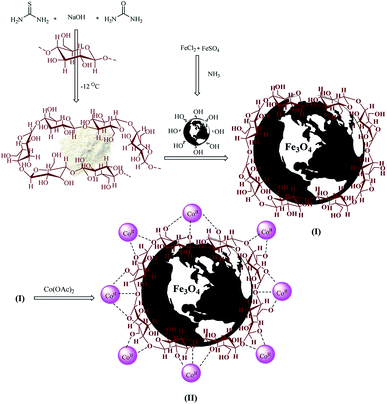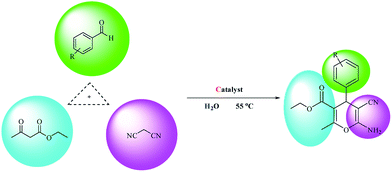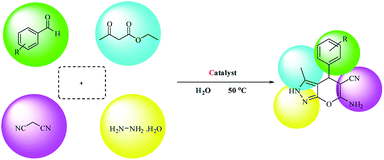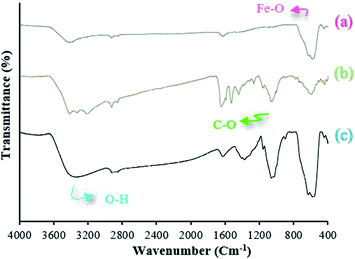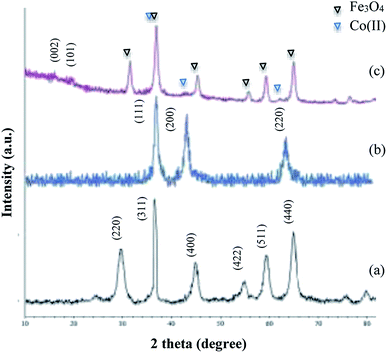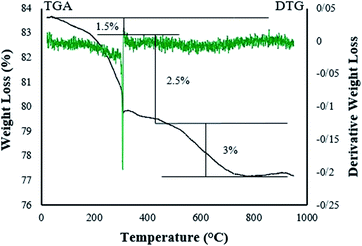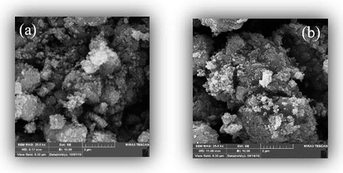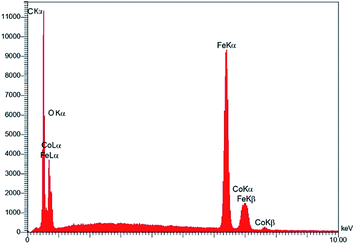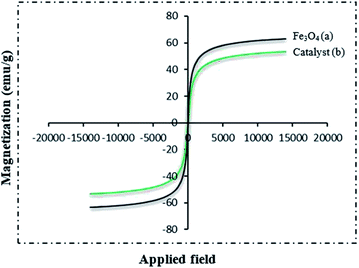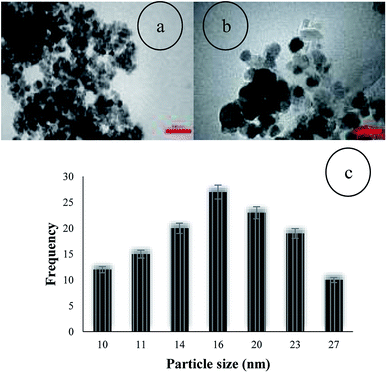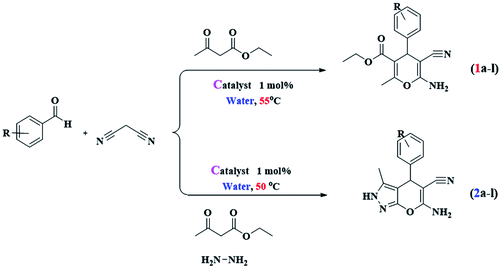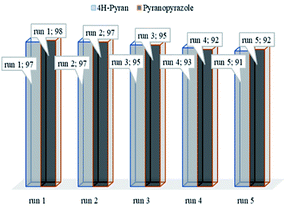 Open Access Article
Open Access ArticleRetracted Article: Novel biocompatible core/shell Fe3O4@NFC@Co(II) as a new catalyst in a multicomponent reaction: an efficient and sustainable methodology and novel reusable material for one-pot synthesis of 4H-pyran and pyranopyrazole in aqueous media†
Pouya Ghamari Kargar a,
Ghodsieh Bagherzade
a,
Ghodsieh Bagherzade *a and
Hossein Eshghi
*a and
Hossein Eshghi b
b
aDepartment of Chemistry, Faculty of Sciences, University of Birjand, Birjand, 97175-615, Iran. E-mail: gbagherzade@gmail.com; bagherzadeh@birjand.ac.ir; Fax: +98 56 32345192; Tel: +98 56 32345192
bDepartment of Chemistry, Faculty of Science, Ferdowsi University of Mashhad, Mashhad, Iran
First published on 8th October 2020
Abstract
Today, due to the developing need for inexpensive catalysts, recyclable magnetic nanocatalysts immobilized on polysaccharides possess many advantages over classical heterogeneous catalysts. However, cellulose has been an appealing material in catalysis science and technology. In this work, by controlling the interaction between the inorganic complexes and the support material, we designed a high activity nanostructured combination of a magnetic nanoparticle Fe3O4@NFC@Co(II) terminated complex as a multi-nuclear catalyst. This protocol involves an environment friendly approach using cobalt acetate. The magnetic nanostructure Fe3O4@NFC@Co(II) can be used as a novel, green, and a powerful catalyst that demonstrates a short reaction time, high yield and easy procedure for the cascade Knoevenagel–Michael-cyclocondensation reaction for the one-pot synthesis of 4H-pyrans and pyranopyrazoles. The superparamagnetic nanocomposite could be conveniently separated by using an external magnet. Moreover, the catalyst could be reused at least five times in new reaction runs without a noticeable loss of activity. The prepared catalyst was characterized by FT-IR, XRD, VSM, FESEM, EDAX, TEM, ICP, and TGA techniques. The experiments were achieved with good yields and implied that the catalytic method was effective and convenient for heterocyclic synthesis.
Introduction
In cascade reactions, several raw materials are produced in several stages without the separation of any intermediates, changing reaction conditions, or adding reagents. Clean reaction conditions, high atomic economy and efficient complexity in one step are some advantages of this reaction.1,2 Organic syntheses with a focus on “green chemistry”, find this attractive. Interest in this subject for several years has led to the emergence of new and benign methods such as water solvent syntheses, multicomponent reactions and reusable catalysts to save resources and energy.3 Green chemistry emphasizes the development of environmentally benign chemical processes and technologies. The most important criterion for the efficiency and feasibility of a process is to minimize the number of synthesis and purification steps as much as possible. Multi-component reactions (MCR) in this area are a promising and great success in green chemistry.4 In multi-component reactions, complex and valuable structures are synthesized very quickly and efficiently over a short period without limits introduced by intermediates. Therefore, by reducing the synthesis steps compared to traditional methods, the reaction will be faster and more efficient.5 MCRs are a special category of organic reaction in which the product in question is created during the step of combining raw materials. The interest and effort from notable chemists towards multi-component reactions has led to the development and advancement of multi-component reactions to make them more responsive and optimized. Therefore, partial reactions are considered to be the best techniques in green chemistry. These reactions have become increasingly important in organic and pharmaceutical chemistry and have become one of the most effective and economical tools for the simultaneous synthesis of compounds.6,7 Pyrans and pyranopyrazoles are a group of important heterocycles that have a large number of natural compounds in their structure and show different biological activity. Pyrans are widely used in cosmetics, pigments, and medicinal chemistry.8–10 In addition, its compounds and derivatives play an important role in the biological-organic and chemical activities of biologics and are widely used as the main nucleus of photochromic materials.11 Pyrans and the valuable derivatives of pyrans have been found in many natural products.12 These compounds have been considered valuable due to their biological and medicinal properties,13–20 such as their anti-bacterial,21 anti-microbial,22 anti-allergic,23 anti-rheumatism24 and anti-cancer25 properties. Also, pyrans are used as memory enhancers to treat neurological diseases such as Alzheimer's,26 Huntington's,27 Parkinson's28 and Down syndrome.29 Also, pyranopyrazoles often have important roles based on their biological activity, which includes anti-inflammation30 and insecticidal effects,31 besides being identified as a screening kit for the Chk1 kinase inhibitor.32 Different methods have been reported33–40 for the synthesis of these derivatives. However, given the goal of green chemistry and planning to make more use of green and inexpensive compounds, we are looking for a way to introduce a catalytic system, which is environmentally friendly, cost-effective, and provides a high power and maximum efficiency in a short time. Today, nanocomposite catalysts are widely regarded by researchers as stable catalysts.40 Among them, superparamagnetic nanoparticles are widely used due to their easy separation for a variety of organic artificial developments.41–44 Polysaccharides with a common form of more than ten monosaccharides are very abundant in nature with sources such as seaweed and plants like wheat, rice, vegetables, etc.45,46 Furthermore, the important benefits of these polysaccharides include safe use, non-toxic nature, easy production, abundant resources, and low-cost.47 Cellulose is a polysaccharide material that is extracted from renewable sources and has been widely considered due to the simplicity of its environmentally-friendly production and low cost. Some of the most important commercial applications of cellulose are food paper, textiles, cosmetics, and pharmaceuticals.48The goal of our research team is to provide a novel multi-core catalyst that has high power, short reaction time, recyclability in multi-stage processes and non-toxic reactivity (Scheme 1). This protocol from both the economic and synthetic point of view possesses several advantages like reduced pollution, lower cost, and simplicity in processing, which are beneficial to the industry as well as to the environment. Water is a desirable medium due to its features that include eco-friendly, safe, non-toxic, non-flammable, clean, green, inexpensive, and readily available. Therefore, the metal is placed on the metal cavities covered with cellulose to achieve high performance and resistance to the synthesis of 4H-pyran (Scheme 2) and pyranopyrazole (Scheme 3) with a safe solvent, which these compounds have good medicinal properties. This catalyst Fe3O4@NFC@Co(II) greatly reduced the cost of this transformation, and the resulting operation and work-up procedures were greatly simplified.
Result and discussion
The design of organic reactions in aqueous environments is another area of progress in green chemistry. Water is a highly soluble and environmentally friendly solvent. This protocol provides flexibility in regulating complexity and molecular diversity. After the reactions were complete, the pure product was simply crystallized from ethanol without the use of any chromatographic method almost immediately. FT-IR spectra for the samples of Fe3O4 MNPs (a), Fe3O4 functionalized with nanofiber cellulose (Fe3O4@NFC) (b), Fe3O4@NFC@Co(II) (c) are shown in Fig. 1. The FT-IR spectrum for the MNPs (a) shows a stretching vibration of the –OH group at about 3440 cm−1, which are attached to the surface iron atoms. The strong absorption at 581 cm−1 is characteristic of the Fe–O stretching vibration, which illustrates the existence of Fe3O4 components.In the FT-IR spectrum of Fe3O4@NFC (Fig. 1b), the existence of the anchored nanofiber cellulose is confirmed by the stretching vibration of the aliphatic C–H group that appears at 2920 cm−1, and also the broad band emerging at 3396–3432 cm−1 and 1064 cm−1, which is related to the O–H and C–O stretching vibrations, respectively. The FT-IR spectrum of catalyst Fe3O4@NFC@Co(II) (Fig. 1c) is proof that metal cobalt has been successfully attached. In the FT-IR of the catalyst, the C–O bond shifted to a lower wavenumber and appears at 1036 cm−1, which illustrates the formation of NFC@Co(II) complexes. The structure of the synthesized nanocatalyst was investigated by X-ray powder diffraction analysis (XRD) (Fig. 2). The XRD pattern shows the characteristic peaks of bare Fe3O4 at 2θ = 30.3°, 35.8°, 43.6°, 54.8°, 57.3°, and 63.2° corresponding to the reflections of the (220), (311), (400), (422), (511), and (440) planes. The XRD pattern of Fe3O4@NFC@Co(II) catalyst matches well with the characteristic peaks of bare Fe3O4, which indicates the retention of the crystalline spinel ferrite core structure during functionalization of MNPs. Strong peaks at 2θ = 36.71°, 42.47° and 61.64° corresponding to the (111), (200) and (220) crystallographic phases in XRD pattern are related to CoO.49 Also, new peaks appeared at 2θ = 18.7 and 20.3, which are attributed to the cellulose species. The XRD diagram of reused catalyst shows that the structure of the catalyst is stable during the reaction.
Thermogravimetric analysis (TGA) was used to determine the thermal stability and percentage of chemisorbed organic functional groups on the surface of the magnetic nanoparticles. Fig. 3 shows the TG/DTG thermogram for the Fe3O4@NFC@Co(II) catalyst. The weight loss of about 4% in the TGA curve of Fe3O4, at temperatures below 300 °C is assigned to the removal of physically adsorbed organic solvents and surface –OH groups (Fig. 3). Moreover, the weight loss of about 3% in the temperature range between 300 and 700 °C may be due to the thermal crystal phase alteration from Fe3O4 to γ-Fe2O3.24 There are three weight loss steps in the TGA curve of Fe3O4@NFC@Co(II) (Fig. 3b). Firstly, a weight loss of about 1.5% below 200 °C is observed, which is owing to the removal of water molecules from the catalyst surface. The second and third steps of weight losses at 200–800 °C may correspond to the degradation of a nanofiber cellulose complex.
The FESEM images of the Fe3O4@NFC@Co(II) nanocatalyst at different magnifications are shown in Fig. 4. According to Fig. 5, the surface morphology of the catalyst shows similar and spherical particles with a size of less than 24 nm. The energy dispersive X-ray spectroscopy (EDS) spectrum shows the presence of various elements in the catalyst (Fig. 5).
The magnetic property of Fe3O4 nanoparticles and Fe3O4@NFC@Co(II) were recorded at room temperature using the vibrating sample magnetometer (VSM) technique (Fig. 6). The magnetic measurement shows that Fe3O4@NFC@ Co(II) has a saturated magnetization value of 53.23 emu g−1. The VSM curve of the Fe3O4 nanoparticles is 63.23 emu g−1, which has a higher magnetic value in comparison with the synthesized nanocatalyst. Reduction in the magnetic property of Fe3O4@NFC@Co(II) is due to the coating of cellulose and the attached organic layers on Fe3O4 nanoparticles. The morphology and nanoparticle size of the catalyst were characterized by scanning electron microscopy.
The loading amount of Co on the Fe3O4@NFC was determined by inductively coupled plasma atomic emission spectrometry (ICP-AES). The ICP analysis showed that the amount of cobalt in the catalyst was 1.63 × 10−3 mol g−1. The particle size distribution of Fe3O4@NFC@Co(II) was evaluated using TEM, which demonstrated that the average diameter of the particles was 16 nm. TEM images also showed that the NPs are spherical and relatively monodispersed (Fig. 7).
Catalytic study
After the preparation of Fe3O4@NFC@Co(II), its catalytic activities were evaluated for the 4H-pyrane and pyranopyrazole reaction. For this purpose, hydrazine hydrate, ethyl acetoacetate, benzaldehyde, and malononitrile were used in the model pyranopyrazole reaction and malononitrile, ethyl acetoacetate and various aldehydes were used in a model 4H-pyrane reaction to optimize the reaction conditions; the results are discussed in Table 1. The reaction of benzaldehyde (1 mmol) with malononitrile (1 mmol) and ethyl acetoacetate (1 mmol) for 4H-pyrane and benzaldehyde (1 mmol), hydrazine hydrate (1 mmol), malononitrile (1 mmol), and ethyl acetoacetate (1 mmol) for pyranopyrazole was chosen as a simple model reaction to optimize the reaction conditions, including catalyst amount, solvent, base, and effect of temperature (Table 1). When the reactions were attempted without a catalyst, it was found that only a low yield of product was obtained even after 1 h. This result suggests that a catalyst plays a critical role in these reactions. Initially, different solvents such as H2O, dimethylformamide (DMF), tetrahydrofuran (THF), polyethylene glycol (PEG-400), acetonitrile (CH3CN), toluene, dioxane, ethanol, and no solvent were examined (entries 1–9) in the presence of 1 mol% of Fe3O4@NFC@Co(II).| Entry | Solvent | Catalyst (mol%) | Temp (°C) | Time (min) | Con. yieldb | Yieldc (%) |
|---|---|---|---|---|---|---|
| a Reaction conditions: aldehyde (1.0 mmol), malononitrile (1.0 mmol), ethyl acetoacetate (1.0 mmol), catalyst (1 mol%) and H2O (2 mL), 55 °C.b Conversion yield (%).c Isolated yield (%). | ||||||
| 1 | EtOH | 1 | 70 | 60 | 85 | 75 |
| 2 | DMF | 1 | 100 | 30 | 70 | 65 |
| 3 | THF | 1 | 60 | 60 | 40 | 25 |
| 4 | Dioxane | 1 | 100 | 60 | 90 | 75 |
| 5 | CH3CN | 1 | 100 | 60 | 60 | 45 |
| 6 | Toluene | 1 | 100 | 60 | 90 | 80 |
| 7 | PEG-400 | 1 | 70 | 60 | 95 | 88 |
| 8 | H2O | 1 | 70 | 15 | 100 | 98 |
| 9 | Neat | 1 | 70 | 60 | 98 | 90 |
| 10 | Neat | 1 | 70 | 30 | 75 | 60 |
| 11 | H2O | 0.5 | 70 | 45 | 90 | 80 |
| 12 | H2O | 0.7 | 70 | 30 | 95 | 87 |
| 13 | H2O | 1 | 70 | 15 | 100 | 97 |
| 14 | H2O | 1.2 | 70 | 15 | 100 | 98 |
| 15 | H2O | 1 | 25 | 60 | 80 | 65 |
| 16 | H2O | 1 | 45 | 30 | 93 | 85 |
| 17 | H2O | 1 | 55 | 15 | 100 | 97 |
| 18 | H2O | 1 | 65 | 15 | 100 | 98 |
| 19 | H2O | 1 | 75 | 15 | 100 | 98 |
In solvents like PEG, water or no solvent (entries 6–9), high yields were observed, but the highest yields were obtained in water for the 4H-pyrane and pyranopyrazole reactions. Examination of the effect of solvent (Tables 1 and 2) for the 4H-pyrane and pyranopyrazole reaction shows that the conversion yield is a function of solvent polarity. Reactions in non-polar solvents have low conversion and in polar solvents, more complete conversion is achieved, except for in dioxane, tetrahydrofuran and toluene. When we analyzed the products, unfortunately instead of completing the reaction, a mixture of product and alkylidyne intermediate (I) and (III) (Schemes 4 and 5) was created. CH3CN is a polar solvent, so in the process of reacting, we found that due to its low nucleophilic power, it may not be a suitable solvent for the development of the reaction.50 As a result, we noticed an isolated yield in PEG, water and no solvent, where water has a good conversion yield for both reactions. In the next step, this model reaction was examined with different temperatures including room temperature, 40, 50, 60, and 80 °C for both reactions, and the best results were obtained at 55 °C for 4H-pyrane and 50 °C for pyranopyrazole. Increasing the temperature to 75 °C did not effectively increase the yield of the product (Tables 1 and 2, entry 19). Finally, to optimize the catalyst amount, different quantities of catalyst were appraised in the model reaction. As shown in Tables 1 and 2 for the 4H-pyrane and pyranopyrazole reactions, the lack of catalyst resulted in a low yield of the product after 24 h but experiments showed that 1 mol% of catalyst for both 4H-pyrane and pyranopyrazole is an adequate amount for the completion of the reactions. Using more of the catalysts did not effectively increase the yield or decrease the time of the reactions (Tables 1 and 2, entry 11–14). The 4H-pyrane derivatives and pyranopyrazole derivatives were obtained in satisfactory yields and the results are summarized in Table 3. However, the results of the 4H-pyrane and pyranopyrazole reactions depend on the type of halide, the positions of the substitution groups on the aromatic ring, the effect of various electron donating and electron withdrawing groups, and the catalyst activity. The suggested mechanism for the 4H-pyrane and pyranopyrazole reaction in the presence of the Fe3O4@NFC@Co(II) catalyst is outlined in Schemes 2 and 3.28
| Entry | Solvent | Catalyst (mol%) | Temp (°C) | Time (min) | Con. yieldb | Iso. yieldc |
|---|---|---|---|---|---|---|
| a Reaction conditions: hydrazine hydrate 96% (1 mmol) and ethyl acetoacetate (1 mmol), aldehyde (1 mmol), malononitrile (1 mmol), water (2 mL) catalyst (1 mol%) and H2O (2 mL), 50 °C.b Conversion yield (%): calculated based on benzaldehyde consumption.c Isolated yield (%): calculated based on the product pyranopyrazole. | ||||||
| 1 | EtOH | 1 | 70 | 60 | 75 | 67 |
| 2 | DMF | 1 | 100 | 30 | 85 | 75 |
| 3 | THF | 1 | 60 | 60 | 83 | 70 |
| 4 | Dioxane | 1 | 100 | 60 | 90 | 80 |
| 5 | CH3CN | 1 | 100 | 60 | 60 | 50 |
| 6 | Toluene | 1 | 100 | 60 | 97 | 91 |
| 7 | PEG-400 | 1 | 70 | 60 | 97 | 91 |
| 8 | H2O | 1 | 70 | 15 | 100 | 98 |
| 9 | Neat | 1 | 70 | 60 | 95 | 90 |
| 10 | Neat | 1 | 70 | 30 | 65 | 55 |
| 11 | H2O | 0.5 | 70 | 45 | 90 | 85 |
| 12 | H2O | 0.7 | 70 | 30 | 98 | 90 |
| 13 | H2O | 1 | 70 | 15 | 100 | 98 |
| 14 | H2O | 1.2 | 70 | 15 | 100 | 98 |
| 15 | H2O | 1 | 25 | 60 | 80 | 70 |
| 16 | H2O | 1 | 40 | 30 | 95 | 85 |
| 17 | H2O | 1 | 50 | 15 | 100 | 98 |
| 18 | H2O | 1 | 60 | 15 | 100 | 95 |
| 19 | H2O | 1 | 75 | 15 | 100 | 95 |
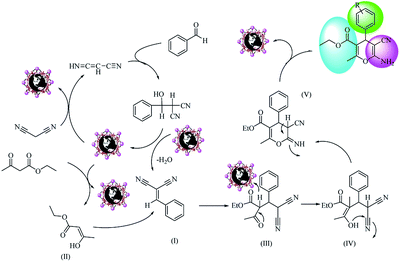 | ||
| Scheme 4 Possible reaction mechanism for one-pot synthesis of polyfunctionalized 4H-pyrans over Fe3O4@NFC@Co(II). | ||
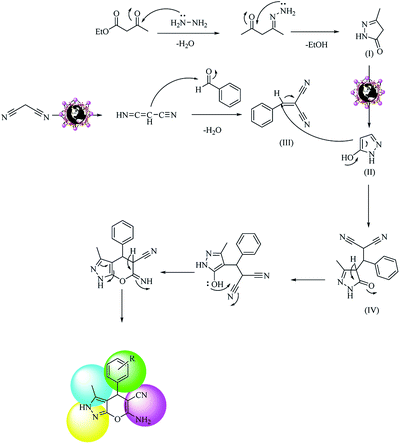 | ||
| Scheme 5 Possible reaction mechanism for one-pot synthesis of polyfunctionalized pyranopyrazole over Fe3O4@NFC@Co(II). | ||
| Entry | Aldehyde | Product | Time (min) | Yielda (%) | TON | TOF | Mp (°C) | Ref. | |
|---|---|---|---|---|---|---|---|---|---|
| Obtained | Reported | ||||||||
| a Isolated yield. | |||||||||
| 1 | Benzaldehyde | 1a | 15 | 97 | 107.7 | 430 | 209–210 | 208–210 | 51 |
| 2 | 4-Chlorobenzaldehyde | 1b | 15 | 93 | 103.3 | 413.2 | 172 | 172–174 | 51 |
| 3 | 4-Bromobenzaldehyde | 1c | 10 | 92 | 102.2 | 638.8 | 178–179 | 178 | 52 |
| 4 | 4-Hydroxybenzaldehyde | 1d | 15 | 90 | 100 | 400 | 177 | 175–177 | 53 |
| 5 | 4-Methoxybenzaldehyde | 1e | 20 | 95 | 105.5 | 319.8 | 137 | 135–137 | 52 |
| 6 | 4-Methylbenzaldehyde | 1f | 20 | 85 | 94.4 | 286.2 | 174–176 | 175–177 | 51 |
| 7 | 4-Fluorobenzaldehyde | 1g | 10 | 94 | 104.4 | 652.7 | 274–276 | 274–277 | 51 |
| 8 | 4-Nitrobenzaldehyde | 1h | 15 | 88 | 97.7 | 391.1 | 182–183 | 180–183 | 54 |
| 9 | 3-Nitrobenzaldehyde | 1i | 15 | 83 | 92.2 | 368.8 | 190 | 189–191 | 55 |
| 10 | 2-Nitrobenzaldehyde | 1j | 15 | 90 | 100 | 400 | 181–182 | 181–183 | 56 |
| 11 | 2-Chlorobenzaldehyde | 1k | 10 | 95 | 105.5 | 659.7 | 194–195 | 193–195 | 55 |
| 12 | 2-Bromobenzaldehyde | 1l | 15 | 95 | 105.5 | 422.2 | 186 | 185–187 | 55 |
| 13 | Benzaldehyde | 2a | 15 | 98 | 108.8 | 435.5 | 262–263 | 261–263 | 57 |
| 14 | 4-Chlorobenzaldehyde | 2b | 15 | 95 | 105.5 | 422.2 | 231–233 | 231 | 57 |
| 15 | 4-Bromobenzaldehyde | 2c | 15 | 90 | 100 | 400 | 172–174 | 172–174 | 58 |
| 16 | 4-Hydroxybenzaldehyde | 2d | 20 | 90 | 100 | 303 | 254–256 | 255–257 | 59 |
| 17 | 4-Methoxybenzaldehyde | 2e | 20 | 88 | 97.7 | 296.3 | 211–212 | 210–212 | 60 |
| 18 | 4-Methylbenzaldehyde | 2f | 25 | 88 | 97.7 | 234 | 213–215 | 212–215 | 61 |
| 19 | 4-Fluorobenzaldehyde | 2g | 15 | 90 | 100 | 400 | 239–241 | 240–242 | 62 |
| 20 | 4-Nitrobenzaldehyde | 2h | 20 | 95 | 105.5 | 319.8 | 247–249 | 246–248 | 60 |
| 21 | 3-Nitrobenzaldehyde | 2i | 20 | 92 | 102.2 | 309.7 | 194 | 192–194 | 60 |
| 22 | 2-Nitrobenzaldehyde | 2j | 20 | 95 | 105.5 | 319.8 | 216 | 216–218 | 57 |
| 23 | 2-Chlorobenzaldehyde | 2k | 20 | 85 | 94.4 | 286.2 | 241–243 | 240–242 | 60 |
| 24 | 2-Bromobenzaldehyde | 2l | 20 | 83 | 92.2 | 279.5 | 232–233 | 232–235 | 61 |
Recyclability of the catalyst
The recycling of the heterogeneous catalysts is an important aspect for commercial applications. To analyze this, the recovery and reusability of the catalyst were examined for the 4H-pyrane reaction of benzaldehyde with malononitrile and ethyl acetoacetate, and the pyranopyrazole reaction of benzaldehyde, hydrazine hydrate, malononitrile, and ethyl acetoacetate as model reactions under the optimized conditions. After the completion of the reaction, the catalyst was simply separated from the reaction mixture using an external magnet and washed with water and ethanol to remove organic residuals, dried, and reused for the next runs. As shown in Fig. 8, the recycled catalyst does not show any significant changes in its activity, which showed that the catalyst was stable and can be reused for the next successive cycles. The catalyst Fe3O4@NFC@Co(II) was analyzed after five steps of recycling by IR and FESEM, as shown in Fig. 9. As shown in the recycling table, there was not much change in the structure of the catalyst morphology or the IR spectrum with several washing steps in these reactions.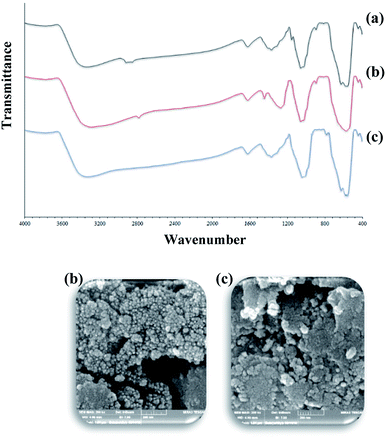 | ||
| Fig. 9 FESEM image and FTIR spectra of Fe3O4@NFC@Co(II): (a) fresh (IR), (b) after 4H-pyran and (c) after pyranopyrazole. | ||
Suggested reaction mechanism
Based on our results, we proposed a mechanism for the one-pot synthesis of polyfunctionalized 4H-pyrans from aldehydes, malononitrile, and an ethyl acetoacetate compound (Scheme 4) and the synthesis of polyfunctionalized pyranopyrazole from aldehydes, malononitrile, hydrazine hydrate and an ethyl acetoacetate compound (Scheme 5). In Scheme 4, the surface metal ions of the catalyst act as active Lewis acids to enolize malononitrile and acetyl acetate in the reaction pathways to prepare the corresponding enols as powerful nucleophiles. Then, the enol of malononitrile attacks benzaldehyde to form an olefin intermediate (I). Therefore, the Knoevenagel condensation reaction takes place between malononitrile and benzaldehyde to form intermediate (I). The Michael addition reaction happens between intermediate (I) and enol (II), forming acetyl acetate derivates to yield intermediate (III). Then, with subsequent steps of intramolecular nucleophilic addition and tautomerization, intermediates (IV) and (V) are formed. Finally, the polyfunctionalized 4H-pyrans are obtained by H+ abstraction from the catalyst. In Scheme 5, the proposed mechanism consists of two parts: the first part involves the formation of pyrazolone from the hydrazine with ethyl acetate, which is converted to pyrazole if Fe3O4@NFC@Co(II) is present. The other part is the formation of phenylidene malononitrile from the concentration of malononitrile from the Knoevenagel condensation with benzaldehyde in the presence of the Fe3O4@NFC@Co(II) catalyst. At the end of the reaction, the Michael's addition combination of (II) was created by intermediates (III) and (IV), which, after an intramolecular nucleophilic attack on the nitrile group, first formed a ring and then a tautomerization gave the pyranopyrazole.Experimental section
Materials and methods
Cellulose nanofibers were purchased from Sigma Aldrich. Iron(III) chloride, iron(II) sulfate, cobalt(II) acetate, and sodium hydroxide were purchased from Sigma Aldrich. All chemicals were used without further purification. The FT-IR spectra were recorded on a JASCO FT/IR 4600 FT-IR spectrometer. The thermal analysis (TGA) was carried out using a TGA Q600 TA instrument at a heating rate of 10 °C min−1 in air. The powder X-ray diffraction (XRD) was performed with a Philips PW1730. The scanning electron microscopy (FESEM) and the energy dispersive X-ray spectroscopy (EDS) characterization of catalysts was performed using an electron microscope Tescan MIRA3. The melting points of the products were measured by an electrothermal 9100 apparatus. ICP experiments were accomplished using a Varian Vista Pro CCD simultaneous ICP-OES instrument. Magnetic properties of the nanoparticles were measured with a vibrating sample magnetometer (VSM). Transmission electron microscopy (TEM) was performed on a Philips EM208 microscope and was operated at 100 kV.Preparation of the magnetic Fe3O4 nanoparticles (MNPs)
MNPs were synthesized through the co-reduction of Fe(III) and Fe(II) ions with a molar ratio of 2![[thin space (1/6-em)]](https://www.rsc.org/images/entities/char_2009.gif) :
:![[thin space (1/6-em)]](https://www.rsc.org/images/entities/char_2009.gif) 1 in the presence of ammonium hydroxide. In general, a 100 mL solution containing FeCl3·6H2O (2 mmol) and FeSO4·7H2O (1 mmol) was prepared and heated at 80 °C under N2 atmosphere and strongly stirred. Then, 5 mL of 25% NH4OH was slowly injected into this mixture in one step. The black MNPs were instantly formed after adding the ammonia solution to the Fe2+/Fe3+ salt solution. The mixture was stirred for 120 min and then cooled to ambient temperature. Then, dark MNPs were magnetically separated from the solution and washed three times with deionized water.62
1 in the presence of ammonium hydroxide. In general, a 100 mL solution containing FeCl3·6H2O (2 mmol) and FeSO4·7H2O (1 mmol) was prepared and heated at 80 °C under N2 atmosphere and strongly stirred. Then, 5 mL of 25% NH4OH was slowly injected into this mixture in one step. The black MNPs were instantly formed after adding the ammonia solution to the Fe2+/Fe3+ salt solution. The mixture was stirred for 120 min and then cooled to ambient temperature. Then, dark MNPs were magnetically separated from the solution and washed three times with deionized water.62
Preparation of the NFC@Fe3O4 (nanofiber Cellulose@Fe3O4)
To a suspension of Fe3O4 nanoparticles (1.15 g, 5.0 mmol) in deionized water (50 mL), 50 mL of NFC (0.5 g, 2.5 mmol) solution was added drop-wise at room temperature. The mixture was vigorously stirred for 2 h at room temperature and then neutralized with water.63 After the foam had subsided, the resulting Fe3O4@NFC precipitate was isolated using an external magnet, washed twice with deionized water, and dried at 60 °C under vacuum for 6 h.Preparation of the Fe3O4@NFC@Co(II)
Based on this method, an excess amount of cobalt(II) acetate in 5 mL ethanolic solution was used to disperse 1 g of Fe3O4@NFC and allowed to react for 2 h at 80 °C under vigorous stirring. Finally, the solid product was separated from the residual cobalt solution by a magnet. Then, the obtained solid product was washed several times with ethanol and dried in an oven at 60 °C for 12 h.Catalytic procedure for synthesis of 4H-pyran derivatives
A mixture of aldehyde (1.0 mmol), malononitrile (1.0 mmol), ethyl acetoacetate (1.0 mmol), water (2 mL), and Fe3O4@NFC@Co(II) (1 mol%) were stirred magnetically in an oil-bath maintained at 55 °C for an appropriate time as mentioned in Table 2. After completion of the reaction as monitored by TLC using n-hexane![[thin space (1/6-em)]](https://www.rsc.org/images/entities/char_2009.gif) :
:![[thin space (1/6-em)]](https://www.rsc.org/images/entities/char_2009.gif) ethyl acetate (60
ethyl acetate (60![[thin space (1/6-em)]](https://www.rsc.org/images/entities/char_2009.gif) :
:![[thin space (1/6-em)]](https://www.rsc.org/images/entities/char_2009.gif) 40) as the eluent, the reaction mixture was allowed to cool to room temperature and then crystallized with ethanol to form a pure crystal of the 4H-pyran (1a–l). The catalyst used in the reaction was reusable for up to 5 cycles (as shown in Fig. 8).
40) as the eluent, the reaction mixture was allowed to cool to room temperature and then crystallized with ethanol to form a pure crystal of the 4H-pyran (1a–l). The catalyst used in the reaction was reusable for up to 5 cycles (as shown in Fig. 8).
General procedure for synthesis pyranopyrazole derivatives
A mixture of hydrazine hydrate 96% (1 mmol), ethyl acetoacetate (1 mmol), aldehyde (1 mmol), malononitrile (1 mmol), water (2 mL) and Fe3O4@NFC@Co(II) (1 mol%) as catalyst were added successively at room temperature under an open atmosphere with vigorous stirring. After completion of the reaction, the reaction mixture was dissolved in ethanol and then the catalyst was separated magnetically. The magnetic Fe3O4 nanoparticles were washed three times with ethanol and then dried at 50 °C for 5 h. The product obtained was pure by TLC. However, the products were further purified by recrystallization from ethanol to form a pure crystal of the pyranopyrazole (2a–l).Selected spectral data
The physical and spectral data of selected products are represented below.![[triple bond, length as m-dash]](https://www.rsc.org/images/entities/char_e002.gif) N), 1692.10 (C
N), 1692.10 (C![[double bond, length as m-dash]](https://www.rsc.org/images/entities/char_e001.gif) O), 1652.27, 1609.54, 1375.88, 1259.12, 1120.31, 1062.19 cm−1. 1H-NMR (400 MHz, DMSO-d6) δ = 1.21–1.30 (3H, CH3, t), 2.50 (3H, CH3, s), 3.81–4.05 (2H, CH2, q), 4.60 (H, CH, s), 6.26 (2H, NH2, s), 7.67–7.88 (5H, H-Ar, m) ppm. 13C-NMR (100 MHz, DMSO-d6): δ = 12.53, 15.37, 55.53, 61.81, 108.85, 119.22, 125.51, 125.72, 127.53, 127.78, 142.85, 152.53, 154.37, 166.85 ppm.
O), 1652.27, 1609.54, 1375.88, 1259.12, 1120.31, 1062.19 cm−1. 1H-NMR (400 MHz, DMSO-d6) δ = 1.21–1.30 (3H, CH3, t), 2.50 (3H, CH3, s), 3.81–4.05 (2H, CH2, q), 4.60 (H, CH, s), 6.26 (2H, NH2, s), 7.67–7.88 (5H, H-Ar, m) ppm. 13C-NMR (100 MHz, DMSO-d6): δ = 12.53, 15.37, 55.53, 61.81, 108.85, 119.22, 125.51, 125.72, 127.53, 127.78, 142.85, 152.53, 154.37, 166.85 ppm.![[triple bond, length as m-dash]](https://www.rsc.org/images/entities/char_e002.gif) N), 1693.41 (C
N), 1693.41 (C![[double bond, length as m-dash]](https://www.rsc.org/images/entities/char_e001.gif) O), 1650.55, 1609.34, 1489.39, 1335.42, 1266.26, 1174.09, 1120.47 cm−1. 1H-NMR (400 MHz, DMSO-d6) δ = 1.01–1.09 (3H, CH3, t), 2.50 (3H, CH3, s), 3.81–4.03 (2H, CH2, q), 4.28 (H, CH, s), 6.26 (2H, NH2, s), 7.29–7.52 (4H, H-Ar, d, d) ppm. 13C-NMR (100 MHz, DMSO-d6): δ = 14.33, 17.37, 38.18, 58.53, 61.65, 107.85, 118.82, 128.54, 128.72, 130.53, 130.78, 131.51, 141.88, 155.55, 158.67, 165.85 ppm.
O), 1650.55, 1609.34, 1489.39, 1335.42, 1266.26, 1174.09, 1120.47 cm−1. 1H-NMR (400 MHz, DMSO-d6) δ = 1.01–1.09 (3H, CH3, t), 2.50 (3H, CH3, s), 3.81–4.03 (2H, CH2, q), 4.28 (H, CH, s), 6.26 (2H, NH2, s), 7.29–7.52 (4H, H-Ar, d, d) ppm. 13C-NMR (100 MHz, DMSO-d6): δ = 14.33, 17.37, 38.18, 58.53, 61.65, 107.85, 118.82, 128.54, 128.72, 130.53, 130.78, 131.51, 141.88, 155.55, 158.67, 165.85 ppm.![[triple bond, length as m-dash]](https://www.rsc.org/images/entities/char_e002.gif) N), 1689.50 (C
N), 1689.50 (C![[double bond, length as m-dash]](https://www.rsc.org/images/entities/char_e001.gif) O), 1645.77, 1608.19, 1483.62, 1374.06, 1262.54, 1180.44, 1068.31 cm−1. 1H-NMR (400 MHz, DMSO-d6) δ = 1.31–1.39 (3H, CH3, t), 2.29 (3H, CH3, s), 3.88–4.00 (2H, CH2, q), 4.55 (H, CH, s), 6.96 (2H, NH2, s), 7.29–7.89 (4H, H-Ar, d, d) ppm. 13C-NMR (100 MHz, DMSO-d6): δ = 14.39, 17.33, 38.15, 58.42, 61.54, 107.84, 119.15, 131.25, 131.51, 143.58, 156.50, 159.25, 165.41 ppm.
O), 1645.77, 1608.19, 1483.62, 1374.06, 1262.54, 1180.44, 1068.31 cm−1. 1H-NMR (400 MHz, DMSO-d6) δ = 1.31–1.39 (3H, CH3, t), 2.29 (3H, CH3, s), 3.88–4.00 (2H, CH2, q), 4.55 (H, CH, s), 6.96 (2H, NH2, s), 7.29–7.89 (4H, H-Ar, d, d) ppm. 13C-NMR (100 MHz, DMSO-d6): δ = 14.39, 17.33, 38.15, 58.42, 61.54, 107.84, 119.15, 131.25, 131.51, 143.58, 156.50, 159.25, 165.41 ppm.![[triple bond, length as m-dash]](https://www.rsc.org/images/entities/char_e002.gif) N), 1684.50 (C
N), 1684.50 (C![[double bond, length as m-dash]](https://www.rsc.org/images/entities/char_e001.gif) O), 1642.77, 1610.19, 1473.62, 1265.54, 1185.44 cm−1. 1H-NMR (400 MHz, DMSO-d6) δ = 0.84–0.91 (3H, CH3, t), 2.33 (3H, CH3, s), 3.78–3.94 (2H, CH2, q), 4.87 (H, CH, s), 6.74 (2H, NH2, s), 6.94–7.14 (4H, H-Ar, m) ppm. 13C-NMR (100 MHz, DMSO-d6): δ = 13.79, 18.03, 56.02, 60.04, 105.44, 119.05, 127.75, 128.35, 129.25, 129.75, 131.81, 142.08, 157.74, 158.45, 165.11 ppm.
O), 1642.77, 1610.19, 1473.62, 1265.54, 1185.44 cm−1. 1H-NMR (400 MHz, DMSO-d6) δ = 0.84–0.91 (3H, CH3, t), 2.33 (3H, CH3, s), 3.78–3.94 (2H, CH2, q), 4.87 (H, CH, s), 6.74 (2H, NH2, s), 6.94–7.14 (4H, H-Ar, m) ppm. 13C-NMR (100 MHz, DMSO-d6): δ = 13.79, 18.03, 56.02, 60.04, 105.44, 119.05, 127.75, 128.35, 129.25, 129.75, 131.81, 142.08, 157.74, 158.45, 165.11 ppm.![[triple bond, length as m-dash]](https://www.rsc.org/images/entities/char_e002.gif) N), 1685.40 (C
N), 1685.40 (C![[double bond, length as m-dash]](https://www.rsc.org/images/entities/char_e001.gif) O), 1642.27, 1611.12, 1474.10, 1261.14, 1174.34 cm−1. 1H-NMR (400 MHz, DMSO-d6) δ = 2.52–2.56 (3H, CH3, t), 2.31 (3H, CH3, s), 3.48–3.92 (2H, CH2, q), 4.87 (H, CH, s), 6.84 (2H, NH2, s), 7.33–7.51 (4H, H-Ar, d, d) ppm. 13C-NMR (100 MHz, DMSO-d6): δ = 13.61, 18.06, 37.55, 56.14, 60.06, 106.19, 119.03, 122.60, 128.35, 128.66, 129.74, 132.46, 143.78, 157.70, 158.35, 165.11 ppm.
O), 1642.27, 1611.12, 1474.10, 1261.14, 1174.34 cm−1. 1H-NMR (400 MHz, DMSO-d6) δ = 2.52–2.56 (3H, CH3, t), 2.31 (3H, CH3, s), 3.48–3.92 (2H, CH2, q), 4.87 (H, CH, s), 6.84 (2H, NH2, s), 7.33–7.51 (4H, H-Ar, d, d) ppm. 13C-NMR (100 MHz, DMSO-d6): δ = 13.61, 18.06, 37.55, 56.14, 60.06, 106.19, 119.03, 122.60, 128.35, 128.66, 129.74, 132.46, 143.78, 157.70, 158.35, 165.11 ppm.![[triple bond, length as m-dash]](https://www.rsc.org/images/entities/char_e002.gif) N), 1640 (C
N), 1640 (C![[double bond, length as m-dash]](https://www.rsc.org/images/entities/char_e001.gif) N), 1610–1490 (C
N), 1610–1490 (C![[double bond, length as m-dash]](https://www.rsc.org/images/entities/char_e001.gif) C), 1390 (C–N), 1055 (C–O) cm−1. 1H-NMR (400 MHz, DMSO-d6) δ = 2.52 (3H, CH3, s), 4.71 (1H, CH-pyrano, s), 6.81 (2H, NH2, s), 7.09–7.27 (5H, H-Ar, m), 11.15 (1H, NH, s) ppm. 13C-NMR (100 MHz, DMSO-d6): δ = 13.40, 26.49, 59.32, 113.63, 117.81, 125.64, 128.72, 129.45, 135.71, 139.45, 163.20, 176.81 ppm.
C), 1390 (C–N), 1055 (C–O) cm−1. 1H-NMR (400 MHz, DMSO-d6) δ = 2.52 (3H, CH3, s), 4.71 (1H, CH-pyrano, s), 6.81 (2H, NH2, s), 7.09–7.27 (5H, H-Ar, m), 11.15 (1H, NH, s) ppm. 13C-NMR (100 MHz, DMSO-d6): δ = 13.40, 26.49, 59.32, 113.63, 117.81, 125.64, 128.72, 129.45, 135.71, 139.45, 163.20, 176.81 ppm.![[triple bond, length as m-dash]](https://www.rsc.org/images/entities/char_e002.gif) N), 1635 (C
N), 1635 (C![[double bond, length as m-dash]](https://www.rsc.org/images/entities/char_e001.gif) N), 1600–1490 (C
N), 1600–1490 (C![[double bond, length as m-dash]](https://www.rsc.org/images/entities/char_e001.gif) C), 1390 (C–N), 1054 (C–O) cm−1. 1H-NMR (400 MHz, DMSO-d6) δ = 2.084 (3H, CH3, t), 4.24 (1H, CH-pyrano, s), 6.37 (2H, NH2, s), 7.13–7.55 (5H, H-Ar, m), 11.01 (1H, NH, s) ppm. 13C-NMR (100 MHz, DMSO-d6): δ = 13.50, 20.09, 59.89, 113.07, 117.81, 126.23, 127.52, 128.36, 131.24, 140.85, 144.51, 162.81, 175.44 ppm.
C), 1390 (C–N), 1054 (C–O) cm−1. 1H-NMR (400 MHz, DMSO-d6) δ = 2.084 (3H, CH3, t), 4.24 (1H, CH-pyrano, s), 6.37 (2H, NH2, s), 7.13–7.55 (5H, H-Ar, m), 11.01 (1H, NH, s) ppm. 13C-NMR (100 MHz, DMSO-d6): δ = 13.50, 20.09, 59.89, 113.07, 117.81, 126.23, 127.52, 128.36, 131.24, 140.85, 144.51, 162.81, 175.44 ppm.Comparison of the catalyst
To investigate the catalytic activity of Fe3O4@NFC@Co(II), we compared the results of the reaction of 4H-pyrane and the reaction of pyranopyrazole (Tables 4 and 5) with the previously reported. Table 4 lists the approaches in the catalyst literature. They each have their advantages, but some of them suffer from various demerits such as the use of an expensive catalyst, harsh reaction condition, toxic chemical and longer reaction time. Catalysts in the literature and their results are given in Table 5. Overall, the obtained catalyst showed better yield and higher TOF values in a shorter reaction time than other catalysts reported in the literature. Thus, the present protocol (Table 5, entry 10) has several advantages as a greener, economic, simple reaction set-up, and product isolation by simple magnet as compared to reported methods for the synthesis of 4H-pyran and pyranopyrazole derivatives.| Entry | Catalyst (mol%) | Solvent | Time (h/min) | Temp. (°C) | Yield (%) | TOF | Ref. |
|---|---|---|---|---|---|---|---|
| 1 | Urea (10) | EtOH![[thin space (1/6-em)]](https://www.rsc.org/images/entities/char_2009.gif) : :![[thin space (1/6-em)]](https://www.rsc.org/images/entities/char_2009.gif) H2O H2O |
8 h | r.t | 86 | 1.075 | 68 |
| 2 | Isonicotinic acid (10) | SF | 10 min | 89 | 90 | 56.25 | 69 |
| 3 | Et3N (10) | EtOH | 15 min | Reflux | 65 | 26 | 70 |
| 4 | L-Proline (10) | H2O | 10 min | Reflux | 90 | 56.25 | 71 |
| 5 | γ-Alumina (30) | H2O | 50 min | Reflux | 80 | 3.19 | 72 |
| 6 | β-Cyclodextrin (10) | EtOH![[thin space (1/6-em)]](https://www.rsc.org/images/entities/char_2009.gif) : :![[thin space (1/6-em)]](https://www.rsc.org/images/entities/char_2009.gif) H2O H2O |
15 min | 80 | 92 | 36.8 | 73 |
| 7 | Piperidine (5) | H2O | 10 min | r.t | 83 | 66.4 | 74 |
| 8 | HDBAC (30) | EtOH | 45 min | Reflux | 73 | 3.24 | 75 |
| 9 | B(OH)3 (10) | SF | 10 min | 70 | 85 | 53.12 | 76 |
| 10 | Fe3O4@NFC@Co(II) (0.9) | H2O | 15 min | 50 | 98 | 435.5 | This work |
Conclusion
In summary, this powerful multi-core catalyst Fe3O4@NFC@Co(II) can be used as a novel, green, efficient, and reusable nanocatalyst for 4H-pyrane and pyranopyrazole reactions. This catalyst offers several advantages including high catalytic activity, excellent yields, short reaction time, and mild reaction conditions. Furthermore, the catalyst could be simply recovered from the reaction mixture using an external magnet and reused up to 5 times without a significant loss in activity.Conflicts of interest
There are no conflicts to declare.Acknowledgements
We gratefully acknowledge the financial support of the research council of the University of Birjand and we also thank the University of Ferdowsi.References
- A. R. Moosavi-Zare, M. A. Zolfigol, O. Khaledian, V. Khakyzadeh, M. D. Farahani and H. G. Kruger, New J. Chem., 2014, 38(6), 2342–2347 RSC.
- A. R. Moosavi-Zare, M. A. Zolfigol, O. Khaledian, V. Khakyzadeh, M. H. Beyzavi and H. G. Kruger, Chem. Eng. J., 2014, 248, 122–127 CrossRef CAS.
- (a) M. Bakherad, A. Keivanloo, A. H. Amin and P. Ghamari kargar, Iran. J. Catal., 2018, 3, 179–187 Search PubMed; (b) A. Khazaei, A. R. Moosavi-Zare, Z. Mohammadi, V. Khakyzadeh and J. Afsar, J. Chin. Chem. Soc., 2016, 63(2), 165–170 CrossRef CAS.
- M. Dabiri, P. Salehi, S. Otokesh, M. Baghbanzadeh, G. Kozehgary and A. A. Mohammadi, Tetrahedron Lett., 2005, 46(36), 6123–6126 CrossRef CAS.
- (a) P. A. Wender, S. T. Handy and D. L. Wright, Chem. Ind., 1997, 765 CAS; (b) B. M. Trost, Angew. Chem., Int. Ed., 1995, 34, 259 CrossRef CAS.
- (a) S. Tu, B. Jiang, Y. Zhang, R. Jia, J. Zhang, C. Yao and S. Feng, Org. Biomol. Chem., 2007, 5, 355 RSC; (b) D. Tejedor and F. Garcia-Tellado, Chem. Soc. Rev., 2007, 36, 484 RSC; (c) D. J. Ramon and Y. Miguel, Angew. Chem., Int. Ed., 2005, 44, 1602 CrossRef CAS; (d) J. Zhu and H. Bienayme, Multicomponent reactions. John Wiley & Sons, 2006 Search PubMed; (e) A. Domling, Chem. Rev., 2006, 106, 17 CrossRef.
- J. P. Wan, S. F. Gan, G. L. Sun and Y. J. Pan, J. Org. Chem., 2009, 74, 2862 CrossRef CAS.
- Y. Morinaka and k. Takahashi, Jpn. Kokai Tokkyo Koho, JP52017498, 1977transChem. Abstr., 1977, 87, 102299 Search PubMed.
- E. C. Witte, P. Neubert and A. Roesch, Ger Offen, DE3427985, 1986transChem. Abstr., 1986, 104, 224915f Search PubMed.
- E. A. Hafez, M. H. Elnagdi, A. A. Elagamey and F. A. El-Taweel, Heterocycles, 1987, 26, 903907 Search PubMed.
- (a) R. Y. Guo, Z. M. An, L. P. Mo, R. Z. Wang, H. X. Liu, S. X. Wang and Z. H. Zhang, ACS Comb. Sci., 2013, 15, 557 CrossRef CAS; (b) S. Wang, Q. Qi, C. Li, G. Ding and S. H. Kim, Dyes Pigm., 2011, 89, 188 CrossRef CAS.
- (a) D. Lu, Y. Li and Y. Gong, J. Org. Chem., 2010, 75, 6900 CrossRef CAS; (b) K. Nicolaou, J. Pfefferkorn, A. Roecker, G. Q. Cao, S. Barluenga and H. Mitchell, J. Am. Chem. Soc., 2000, 122, 9939 CrossRef CAS; (c) H. T. Nguyen, M. C. Lallemand, S. Boutefnouchet, S. Michel and F. Tillequin, J. Nat. Prod., 2009, 72, 527 CrossRef CAS; (d) A. W. Schuppe, Y. Zhao, Y. N. Liu and T. R. Newhouse, J. Am. Chem. Soc., 2019, 141, 9191 CrossRef; (e) S. J. Kalita, N. Saikia, D. C. Deka and H. Mecadon, Res. Chem. Intermed., 2016, 42, 6863 CrossRef CAS.
- J. Zamocka, E. Misikova and J. Durinda, Pharmazie, 1991, 46, 610613 Search PubMed.
- J. L. Wang, D. Liu, Z. J. Zhang, S. Shan, X. Han, S. M. Srinivasula, C. M. Croce, E. S. Alnemri and Z. Huang, Proc. Natl. Acad. Sci. U. S. A., 2007, 97, 71247129 Search PubMed.
- A. M. M. El-Saghier and M. B. Naili, ARKIVOC, 2007, 16, 83–91 Search PubMed.
- R. R. Kumar, S. Perumal, P. Senthilkumar, P. Yogeeswari and D. Sriram, Bioorg. Med. Chem. Lett., 2007, 17, 64596462 Search PubMed.
- I. J. S. Fairlamb, L. R. Marrison, J. M. Dickinson, F. J. Lu and J. P. Schmidt, Bioorg. Med. Chem., 2004, 12, 42854299 CrossRef.
- M. D. Aytemir, D. D. Erol, R. C. Hider and M. Ozalp, Turk. J. Chem., 2003, 27, 757764 Search PubMed.
- M. Kidwai, S. Saxena, M. K. R. Khan and S. S. Thukral, Bioorg. Med. Chem. Lett., 2005, 15, 42954298 Search PubMed.
- (a) D. Kumar, V. B. Reddy, S. Sharad, U. Dube and S. Kapur, Eur. J. Med. Chem., 2009, 44, 3805 CrossRef CAS; (b) N. P. Selvam, T. H. Babu and P. T. Perumal, Tetrahedron, 2009, 65, 8524 CrossRef CAS.
- L. R. Morgan, B. S. Jursic, C. L. Hooper, D. M. Neumann, K. Thangaraj and B. LeBlanc, Bioorg. Med. Chem. Lett., 2002, 12, 3407 CrossRef CAS.
- G. Zhang, Y. Zhang, J. Yan, R. Chen, S. Wang, Y. Ma and R. Wang, J. Org. Chem., 2012, 77, 878–888 CrossRef CAS.
- C. W. Smith, J. M. Bailey, M. E. Billingham, S. Chandrasekhar, C. P. Dell, A. K. Harvey, C. A. Hicks, A. E. Kingston and G. N. Wishart, Bioorg. Med. Chem. Lett., 1995, 5, 2783 CrossRef CAS.
- K. Niknam and A. Piran, Green Sustainable Chem., 2013, 3, 1–8 CrossRef.
- H. Gourdeau, L. Leblond, B. Hamelin, C. Desputeau, K. Dong, I. Kianicka, D. Custeau, C. Boudreau, L. Geerts and S. X. Cai, Mol. Cancer Ther., 2004, 3, 1375 CAS.
- M. Saha and A. Pal, Synth. Commun., 2013, 43, 1708 CrossRef CAS.
- J. L. Wang, D. Liu, Z. J. Zhang, S. Shan, X. Han, S. M. Srinivasula, C. M. Croce, E. S. Alnemri and Z. Huang, Proc. Natl. Acad. Sci. U. S. A., 2000, 97, 7124 CrossRef CAS.
- M. E. A. Zaki, H. A. Soliman, O. A. Hiekal and A. E. Z. Rashad, Z. Naturforsch., C: J. Biosci., 2006, 61, 1 CAS.
- E. S. Tamany, F. A. El-Shahed and B. H. Mohamed, J. Serb. Chem. Soc., 1999, 6, 918 Search PubMed.
- N. Foloppe, L. M. Fisher, R. Howes, A. Potter, G. S. Robertson and A. E. Surgenor, Bioorg. Med. Chem., 2006, 14, 47924802 Search PubMed.
- Y. M. Litvinov, A. A. Shestopalov, L. A. Rodinovskaya and A. M. Shestopalov, J. Comb. Chem., 2009, 11(5), 914–919 CrossRef CAS.
- S. W. Kshirsagar, N. R. Patil and S. D. Samant, Synth. Commun., 2011, 41, 1320–1325 CrossRef CAS.
- M. B. M. Reddy, V. P. Jayashankara and M. A. Pasha, Synth. Commun., 2010, 40, 2930–2934 CrossRef CAS.
- J. M. Khurana, B. Nand and S. Kumar, Synth. Commun., 2011, 41, 405–410 CrossRef CAS.
- Y. Peng, G. Song and R. Dou, Green Chem., 2006, 8, 573–575 RSC.
- L. G. Sharanina, L. G. Promonenkov, V. V. Puzanova and Y. A. Sharanona, Chem. Heterocycl. Compd., 1982, 18, 607–611 CrossRef.
- M. M. Heravi, Y. S. Beheshtiha, Z. Pirnia, S. Sadjadi and M. Adibi, Synth. Commun., 2009, 39, 3663–3667 CrossRef CAS.
- H. Valizadeha and A. A. Azimib, J. Iran. Chem. Soc., 2011, 8, 123–130 CrossRef.
- A. Maleki, R. Taheri-Ledari, J. Rahimi, M. Soroushnejad and Z. Hajizadeh, ACS Omega, 2019, 4, 1062939 CrossRef.
- A. Maleki, Polycyclic Aromat. Compd., 2018, 38(5), 402–409 CrossRef CAS.
- A. Maleki, M. Aghaei and T. Kari, Polycyclic Aromat. Compd., 2019, 39(3), 266–278 CrossRef CAS.
- S. Parvaz, R. Taheri-Ledari, M. S. Esmaeili, M. Rabbani and A. Maleki, Life Sci., 2020, 240, 117099 CrossRef CAS.
- A. Maleki, Z. Varzi and F. Hassanzadeh-Afruzi, Polyhedron, 2019, 171, 193–202 CrossRef CAS.
- Y. Yu, M. Shen, Q. Song and J. Xie, Carbohydr. Polym., 2018, 183, 91–101 CrossRef CAS.
- A. Kumar, K. M. Rao and S. S. Han, Carbohydr. Polym., 2018, 180, 128–144 CrossRef CAS.
- A. Nouri, M. T. Yaraki, M. Ghorbanpour and S. Wang, Int. J. Biol. Macromol., 2018, 115, 227–235 CrossRef CAS.
- F. Nemati, M. M. Heravi and A. Elhampour, RSC Adv., 2015, 5, 45775–45784 RSC.
- A. Ghorbani-Choghamarani, Z. Darvishnejad and M. Norouzi, Appl. Organomet. Chem., 2015, 29, 170–175 CrossRef CAS.
- G. P. Glaspell, P. W. Jagodzinski and A. Manivannan, J. Phys. Chem. B, 2004, 108(28), 9604–9607 CrossRef CAS.
- A. Sidorenko, N. Li-Zhulanov, P. Mäki-Arvela, T. Sandberg, A. Kravtsova, A. Peixoto and D. Murzin, ChemCatChem, 2020, 12(9), 2605–2609 CrossRef CAS.
- E. Pourian, S. Javanshir, Z. Dolatkhah, S. Molaei and A. Maleki, ACS Omega, 2018, 3, 5012–5020 CrossRef CAS.
- L. F. Gutierrez, E. Nope, H. A. Rojas, J. A. Cubillos, A. G. Sathicq, G. P. Romanelli and J. J. Martínez, Res. Chem. Intermed., 2018, 44, 5559–5568 CrossRef CAS.
- J. M. Khurana and A. Chaudhary, Green Chem. Lett. Rev., 2012, 5, 633–638 CrossRef CAS.
- D. Kumar, V. B. Reddy, S. Sharad, U. Dube and S. Kapur, Eur. J. Med. Chem., 2009, 44, 3805–3809 CrossRef CAS.
- P. B. Hiremath and K. Kantharaju, ChemistrySelect, 2020, 5, 1896–1906 CrossRef CAS.
- X. S. Wang, Z. S. Zeng, M. M. Zhang, Y. L. Li, D. Q. Shi, S. J. Tu, X. Y. Wei and Z. M. Zong, J. Chem. Res., 2006, 228 CrossRef.
- A. R. Moosavi-Zare, M. A. Zolfigol, R. Salehi-Moratab and E. Noroozizadeh, J. Mol. Catal. A: Chem., 2016, 415, 144–150 CrossRef CAS.
- G. M. Reddy and J. Raul Garcia, J. Heterocycl. Chem., 2017, 54, 89–94 CrossRef CAS.
- A. R. Moosavi-Zare, M. A. Zolfigol and A. Mousavi-Tashar, Res. Chem. Intermed., 2016, 42, 7305–7312 CrossRef CAS.
- Y. A. Tayade, S. A. Padvi, Y. B. Wagh and D. S. Dalal, Tetrahedron Lett., 2015, 56, 2441–2447 CrossRef CAS.
- G. M. Reddy and J. Raul Garcia, J. Heterocycl. Chem., 2017, 54, 89–94 CrossRef CAS.
- X. Yu, S. Tong, M. Ge, J. Zuo, C. Cao and W. Song, J. Mater. Chem. A, 2013, 1, 959–965 RSC.
- (a) P. Ghamari kargar, G. Bagherzade and H. Eshghi, RSC Adv., 2020, 10, 32927–32937 RSC; (b) F. F. Kaid, A. T. Totti Silveira Junior and H. E. Toma, ACS Appl. Nano Mater., 2020, 10(6), 530 Search PubMed.
- I. Kharbangar, R. Rohman, H. Mecadon and B. Myrboh, Int. J. Org. Chem., 2012, 2, 282–286 CrossRef CAS.
- N. Azizi, T. S. Ahooie, M. M. Hashemi and I. Yavari, Synlett, 2018, 29, 645–649 CrossRef CAS.
- M. R. Yousefi, O. Goli-Jolodar and F. Shirini, Piperazine, Bioorg. Chem., 2018, 81, 326–333 CrossRef CAS.
- Y. Peng and G. Song, Catal. Commun., 2007, 8, 111–114 CrossRef CAS.
- G. Brahmachari and B. Banerjee, ACS Sustainable Chem. Eng., 2014, 2, 411–422 CrossRef CAS.
- M. A. Zolfigol, M. Tavasoli, R. A. Moosavi-Zare, P. Moosavi, H. G. Kruger, M. Shirid and V. Khakyzadeh, RSC Adv., 2013, 3, 25681 RSC.
- Y. M. Litvinov, A. A. Shestopalov, L. A. Rodinovskaya and A. M. Shestopalov, J. Comb. Chem., 2009, 11, 914–919 CrossRef CAS.
- H. Mecadon, M. R. Rohman, M. Rajbangshi, B. Myrboh, I. Kharkongor and B. M. Laloo, Tetrahedron Lett., 2011, 52(25), 3228–3231 CrossRef CAS.
- H. Mecadon, M. R. Rohman, M. Rajbangshi and B. Myrboh, Tetrahedron Lett., 2011, 52, 2523–2525 CrossRef CAS.
- Y. A. Tayade, S. A. Padvi, Y. B. Wagh and D. S. Dalal, Tetrahedron Lett., 2015, 56, 2441–2447 CrossRef CAS.
- G. Vasuki and K. Kumaravel, Tetrahedron Lett., 2008, 49(39), 5636–5638 CrossRef CAS.
- K. Ablajan, W. Liju, A. Tuoheti and Y. Kelimu, Lett. Org. Chem., 2012, 9, 639–643 CrossRef CAS.
- A. R. Moosavi-Zare, H. Afshar-Hezarkhani and M. M. Rezaei, Polycyclic Aromat. Compd., 2017, 1–9 Search PubMed.
Footnote |
| † Electronic supplementary information (ESI) available. See DOI: 10.1039/d0ra04698a |
| This journal is © The Royal Society of Chemistry 2020 |

